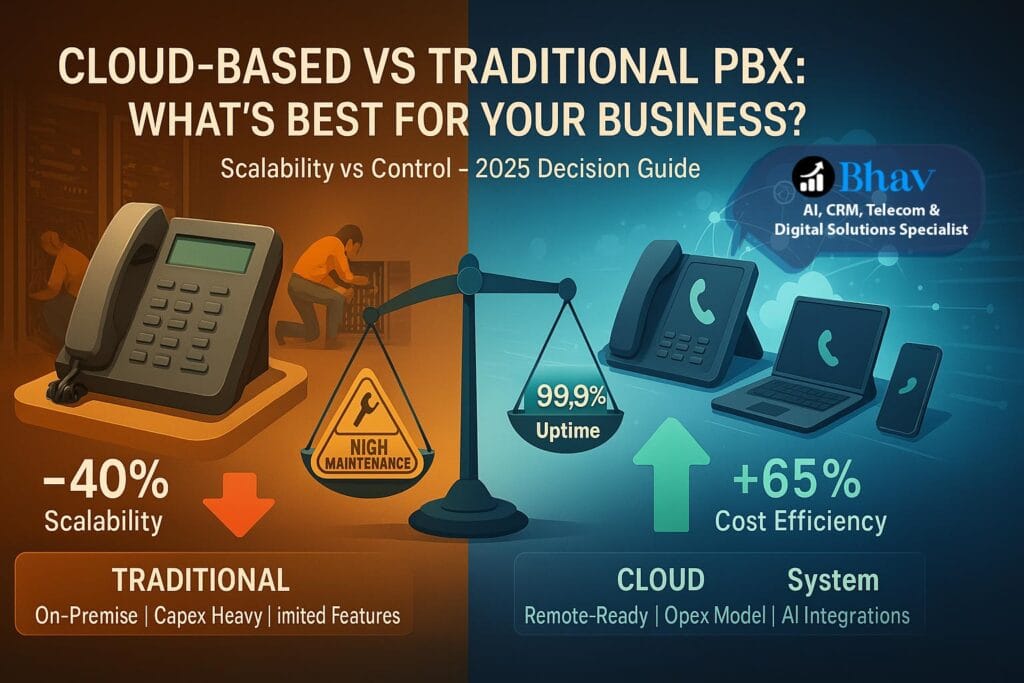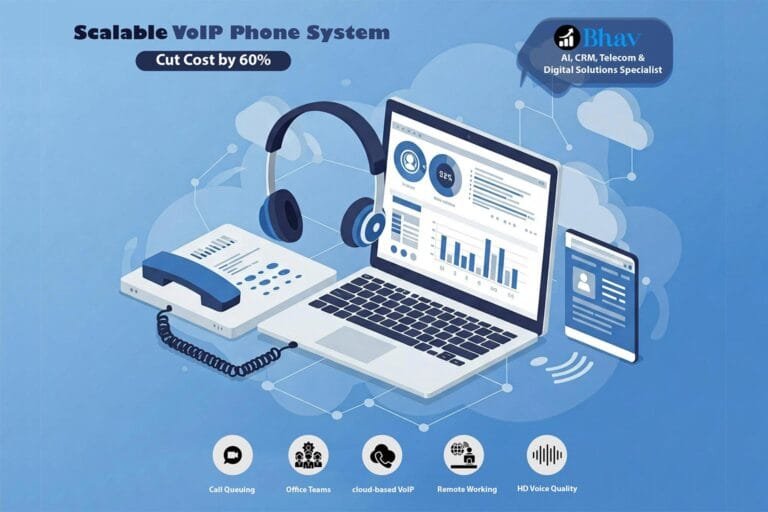
Introduction to Phone Systems
Effective communication is vital for any business, and the choice of a phone system can play a crucial role in ensuring seamless interactions. There are two primary types of phone systems commonly utilized by businesses: traditional PBX (Private Branch Exchange) systems and cloud-based phone systems. Understanding the fundamental differences between these two approaches is essential for making an informed decision.
Traditional PBX systems have been a staple in the business communication landscape for decades. These systems rely on on-premises hardware to manage calls internally and externally. One of the primary advantages of traditional PBX systems is their reliability. Businesses that require consistent service and low latency may prefer this option. However, the initial setup and maintenance costs for these systems can be significant, with ongoing expenses for hardware upgrades and repairs. Additionally, traditional systems can be less flexible, limiting the ability to scale or adapt to the changing needs of a business.
On the other hand, cloud-based phone systems have emerged as a modern solution, leveraging internet connectivity to facilitate communication. These systems offer several advantages, including enhanced flexibility, scalability, and reduced upfront costs. Businesses can easily add or remove lines as needed, allowing them to adapt to fluctuating demand. Moreover, cloud-based phone systems typically come with a range of additional features such as voicemail-to-email, call forwarding, and video conferencing, which can enhance productivity. Nevertheless, reliance on an internet connection may raise concerns about reliability and security, particularly in areas with unstable connectivity.
In conclusion, both traditional PBX systems and cloud-based phone systems have their unique advantages and disadvantages. Understanding these aspects is essential for businesses as they consider which phone system aligns best with their operational needs and future growth strategies.
Understanding Traditional PBX Systems
Traditional Private Branch Exchange (PBX) systems have long been a staple in business communication. These systems operate through a physical setup that manages incoming and outgoing calls, as well as internal communication within an organization. Typically found in larger businesses, traditional PBX systems use a central connecting point that routes calls between various extensions, allowing employees to communicate efficiently without the need for multiple phone lines.
One of the primary functionalities of traditional PBX systems is call management. This includes features like call forwarding, voicemail, and automated attendants, which enhance the user experience and improve operational efficiency. Moreover, traditional PBX systems can be coupled with advanced functionalities through additional hardware or software, allowing businesses to customize their communication capabilities further.
The hardware requirements for traditional PBX systems can be significant. Organizations must invest in various physical components, including telephone sets, wiring, and dedicated servers. This hardware not only involves upfront capital expenditure but also entails ongoing maintenance costs and the need for technical expertise to ensure the system runs smoothly. Consequently, these systems have historically appealed to larger enterprises with the resources to manage such infrastructures.
Despite their advantages, traditional PBX systems have several limitations. Due to the necessity for physical hardware, scaling the system to accommodate growth can be cumbersome and costly. Additionally, as businesses increasingly prioritize mobility and remote work capabilities, traditional systems can struggle to adapt compared to cloud-based alternatives that offer flexibility through internet connectivity.
Overall, while traditional PBX systems have served many businesses well in the past, the evolving landscape of communication technology raises questions about their continued relevance and efficiency in modern corporate environments.
Exploring Cloud-Based Phone Systems
Cloud-based phone systems, often referred to as Voice over Internet Protocol (VoIP) solutions, represent a significant evolution in telecommunications technology. Unlike traditional Private Branch Exchange (PBX) systems that rely heavily on physical infrastructure and on-premises hardware, cloud-based systems operate over the internet. This allows businesses to utilize voice communication services without the need for extensive in-house telephone equipment, streamlining operations and reducing costs associated with installation and maintenance.
One of the notable features of cloud-based phone systems is their scalability. Organizations can easily adjust their service based on current requirements. For instance, when a business undergoes growth, adding new lines or features can be accomplished quickly and without the need for large-scale upgrades. This flexibility is particularly beneficial for businesses that experience fluctuations in demand or seasonal variations, ensuring they only pay for what they need.
Moreover, cloud-based systems offer a range of features that enhance productivity and improve communication. These include call forwarding, voicemail-to-email, video conferencing, and instant messaging, all accessible from multiple devices including smartphones, tablets, and computers. This capability aligns well with the growing trend of remote work, accommodating employees who may work from different locations. Users can remain connected regardless of where they are, allowing for seamless collaboration and communication.
In addition to supporting a mobile workforce, cloud-based phone systems typically provide advanced analytics and reporting capabilities. These features help businesses monitor call performance and customer interactions, facilitating more informed decision-making. As companies increasingly recognize the importance of efficient communication solutions in maintaining competitive advantage, adopting a cloud-based phone system may prove advantageous for meeting modern workforce requirements.
Cost-Benefit Analysis of Phone Systems
When considering the adoption of a phone system for a business, a thorough cost-benefit analysis is essential to making an informed decision. This analysis typically compares cloud-based phone systems with traditional Private Branch Exchange (PBX) systems, assessing both the initial investment as well as ongoing expenses.
Cloud-based phone systems generally require lower initial investments. Businesses typically incur minimal upfront costs associated with hardware purchases, as most of the infrastructure is hosted in the cloud by the service provider. In contrast, traditional PBX systems necessitate significant upfront capital for equipment, installation, and configuration, which can strain finances, especially for small to medium-sized enterprises.
Moving beyond initial costs, ongoing expenses also differ notably. Cloud-based systems follow a subscription-based model, often offering predictable monthly fees that cover maintenance, software updates, and support. This can result in lower total operating costs over time. On the other hand, traditional PBX systems often entail not only sustained operational costs but also periodic maintenance fees and potential emergency repair expenses, which can accumulate unexpectedly if issues arise.
Another crucial factor in this cost-benefit analysis is the aspect of scalability. Cloud-based phone systems allow easy scaling, enabling businesses to add or remove lines as needed without significant expenses or disruptions. Conversely, traditional PBX systems can be rigid; adding new lines typically requires extensive network reconfiguration and can incur additional capital outlay.
Moreover, cloud-based solutions afford organizations access to the latest technology updates without substantial investment. Traditional systems, however, run the risk of becoming outdated, requiring significant capital expenditure for modernizations. Ultimately, the total cost of ownership should incorporate these elements, allowing businesses to weigh not only immediate costs but also future savings and technological efficiencies.
Key Features of Cloud-Based Phone Systems
Cloud-based phone systems have revolutionized communication for businesses, offering a multitude of features that enhance operational efficiency and customer interactions. One of the standout functionalities is Voice over Internet Protocol (VoIP), which allows voice communication to be transmitted over the internet rather than traditional phone lines. This technology not only reduces costs associated with long-distance calls but also provides higher call quality and reliability.
Another significant advantage of cloud phone systems is mobile accessibility. With the increasing trend towards remote work, having the ability to make and receive calls on various devices—smartphones, tablets, or laptops—has become essential. Employees can stay connected regardless of their physical location, ensuring continuous communication with clients and colleagues alike.
Advanced call management features represent another compelling aspect of cloud-based phone systems. Businesses can utilize functionalities such as call forwarding, voicemail-to-email, and automated attendants to streamline communication processes. These features enable organizations to handle high volumes of calls efficiently, reducing wait times for customers and ensuring that important calls are not missed.
Moreover, the seamless integration of cloud phone systems with other software platforms enhances their usability. Many systems offer compatibility with customer relationship management (CRM) software, project management tools, and collaboration platforms. This integration enables businesses to access customer data and communication history during calls, fostering a more personalized customer experience.
Lastly, cloud-based phone systems enhance the overall customer experience through better service offerings. Businesses can provide features like call recording, real-time analytics, and multi-channel communication, which empower them to respond effectively to customer needs. By leveraging these capabilities, organizations can improve client satisfaction and boost loyalty.
Migration Planning: A Checklist for SMBs
For small and medium-sized businesses (SMBs) contemplating a transition from traditional PBX systems to cloud-based phone systems, meticulous planning is essential to facilitate a seamless migration. Below is a comprehensive checklist designed to assist SMBs in navigating this process.
First, assess your current telecom needs. This involves auditing existing equipment, services, and usage patterns. Analyze call volumes, features used, and any specific needs such as remote capabilities or conferencing features. Understanding these requirements will guide your choice of cloud-based provider.
Next, selecting a provider is crucial. Research various cloud phone system vendors, examining their service offerings, pricing structures, and customer support. Pay special attention to reviews and case studies, particularly from SMBs with similar needs. It is advisable to request demos and trial periods to ensure the solution meets your operational demands.
Following provider selection, move onto planning the system design. This step is imperative as it involves choosing the right features and configurations that align with your business objectives. It is wise to involve key stakeholders in this planning stage, ensuring their input is considered in the decision-making process.
Training employees is another vital aspect of the migration plan. Equip your staff with comprehensive training regarding the features and functionality of the new cloud-based phone system. Providing adequate training sessions will significantly reduce the learning curve and enhance user adoption.
Finally, establish a transition timeline. Create a detailed plan that outlines each phase of the migration, from initial setup to full deployment. This timeline should incorporate timelines for testing, feedback collection, and performance evaluations, assuring that implementation aligns with your business goals and minimizes disruption.
By following this checklist, SMBs can confidently navigate the migration process, ensuring that the shift to a cloud-based phone system meets their needs and enhances overall communication efficiency.
Challenges of Transitioning to Cloud-Based Systems
The transition from traditional PBX systems to cloud-based phone systems can pose several challenges for organizations. These challenges can significantly impact the implementation process and overall effectiveness of the new system. One of the primary concerns is data security. Businesses must ensure that sensitive customer information and communication data are protected against potential breaches. Cloud providers typically offer advanced security measures; however, organizations need to conduct thorough research to select reputable providers and assess their security protocols. Failure to address these concerns may lead to data vulnerability.
Another significant challenge is the potential for downtime during the transition phase. Companies may experience interruptions in their communication services, which could affect customer service and employee productivity. To mitigate this issue, businesses should plan the implementation carefully, ideally scheduling it during off-peak hours and conducting thorough testing prior to going live with the new system. This proactive approach can minimize disruption and ensure a smoother transition.
Integration with existing systems poses yet another challenge. Organizations often use various software and tools that may not be compatible with cloud-based phone systems. It is essential for businesses to evaluate their current infrastructure and identify any potential compatibility issues. Developing comprehensive integration strategies can facilitate smoother connectivity between new and existing systems, reducing the likelihood of operational hiccups.
Moreover, employee adaptation to the new technologies can be a concern. Staff may require training to utilize the new cloud-based phone systems effectively. Investing in training sessions and providing ongoing support can ensure that employees become proficient in using the new systems and can harness their full potential. By addressing these challenges with effective strategies, businesses can significantly improve their chances of successfully transitioning to cloud-based phone systems.
Case Studies: Businesses That Made the Switch
As more businesses evaluate their communication strategies, many have successfully transitioned from traditional PBX systems to cloud-based phone systems. This shift is not merely a trend; it reflects a growing recognition of the advantages offered by modern telecommunications technology. Several case studies illustrate the experiences of businesses that made this significant switch, detailing the challenges faced and the resultant benefits.
A notable example is a mid-sized marketing firm that had relied on traditional PBX for many years. The firm encountered limitations such as extensive hardware costs, restrictive scalability, and difficulties in integrating remote work capabilities. Upon switching to a cloud-based phone system, they were able to streamline their communication processes significantly. The transition resulted in reduced operational costs, enhanced flexibility, and improved collaboration among employees, especially those working remotely. Cost-effective scalability also enabled the firm to expand its operations without the burden of additional infrastructure expenditures.
Another compelling case is that of a manufacturing company that faced increasing communication challenges as their workforce grew. Their existing traditional PBX system was unable to accommodate new remote work policies necessitated by global events. After switching to a cloud-based phone system, the company reported improvements in team coordination, as enhanced features such as video conferencing and instant messaging were integrated into their communication model. Moreover, the ability to manage calls from any device ensured uninterrupted communication, further optimizing their operational workflow.
In both instances, the businesses not only overcame the challenges presented by traditional PBX systems but also unlocked new opportunities for growth and innovation. Adopting cloud-based solutions fostered more agile and responsive operations while reducing downtime and associated costs. The transition exemplifies how businesses can leverage technology to adapt to an ever-evolving workplace environment, paving the way for future advancements.
Conclusion: Choosing the Right Phone System for Your Business
Determining the most suitable phone system for your business necessitates careful consideration of various factors, including the size of your organization, budget constraints, and specific telecommunications requirements. Both cloud-based phone systems and traditional PBX solutions offer distinct advantages that can cater to different business needs.
For small to medium-sized enterprises, cloud-based phone systems typically provide a cost-effective solution through reduced infrastructure costs and easier scalability. They allow organizations to access advanced features without the need for substantial upfront investments. This model also facilitates remote work capabilities, which have become increasingly important in today’s dynamic work environment. Businesses seeking flexibility and technological enhancements may find cloud solutions to be the most beneficial.
Conversely, traditional PBX systems might appeal more to larger corporations or businesses requiring enhanced control over their telecommunication environment. These systems can provide reliability and stability while allowing organizations to customize their telephony setup in alignment with specific operational needs. However, this option may involve higher acquisition costs and maintenance obligations, thereby necessitating a thorough evaluation of the long-term budgetary impact.
Ultimately, the appropriate choice between cloud-based and traditional PBX systems hinges on aligning technological capabilities with overall business objectives. Decision-makers must assess organizational requirements, financial contexts, and future expansion plans before arriving at a conclusion. By ensuring that the selected phone system aligns with your strategic goals, you can enhance communication efficiency and improve overall business performance while managing costs effectively.


